With Magic30 in the rear view mirror, Brothers’ War previews are in full swing! As has become the custom here at Drawing Live, let’s take a quick look at all the new mechanics being introduced in set, what their designs hearken back to, and how they might play out. (Then, in a few months, we can give them final grades in Mechanics In Review.)
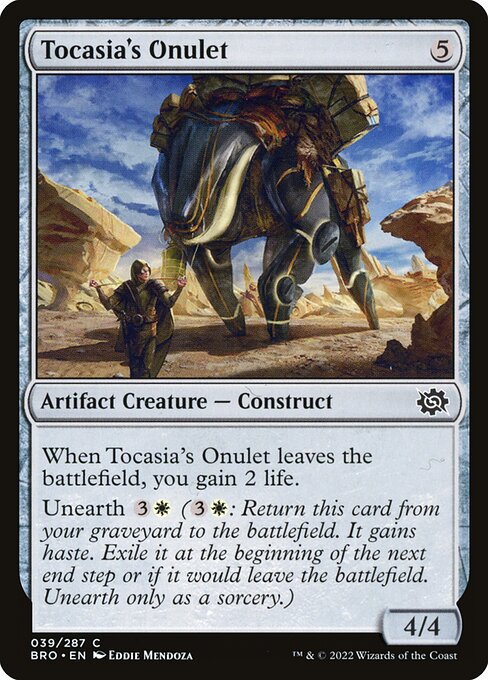
Brothers’ War features two returning mechanics (Unearth and Meld) and introduces five new mechanics—sort of. Prototype is a brand new mechanic while Powerstones were briefly teased in Dominaria. There are three new mechanics in the fifteen Transformers cards which will be in Brother’s War booster packs (though they have a different set code)—we’ll touch on those briefly at the end of the article.
Unearth seems a perfect mechanic for a story about Magic’s most iconic siblings digging up old mechs. Once upon a time, they were powerful and enduring. Ages later, during the Brothers’ War, they were excavated, patched up, and thrown into a brutal conflict that quickly destroyed them for good. It’s a perfect mechanical retelling of Magic’s first story, a great way to get colored mana costs on colorless artifacts (giving them a feel of both old school colorless and contemporary colorful artifacts), and a completely different feel for a mechanic previous about reanimating undead creatures.
Meld is an incredibly splashy mechanic, returning for the second time after its debut in Shadows Over Innistrad. This time, it only exists at mythic rare, so it’s unlikely to happen in Limited more than a handful of times. The mechanic seems to have a bunch of challenges, but perhaps the biggest is that successfully Melding seems akin to a Planeswalker going ultimate: it’s hard and super splashy, but the reward is so powerful that the game will probably end before you actually get to use your new game piece.
Meld seems like a great fit to communicate Urza and Mishra’s legendary transformations and ludicrous amounts of power, so it makes perfect sense as a low density, high impact inclusion.
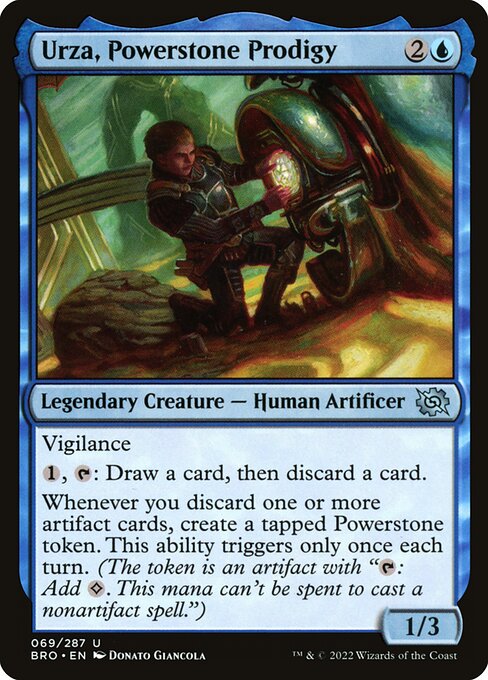
The new Clue on the block
We spoke about Powerstones during Dominaria United preview season, so we’ll be brief here. They’re another iteration in the design vein of artifact tokens, joining Clues, Treasure, Food, and Blood as the next innovation in fractional value. They’re a bit awkwardly worded, using a double negative to spell out the one thing they cannot do (cast nonartifact spells). This wording is shorter and cleaner than alternatives, but it uses implication to tell you what they can do, rather than explicitly tells you what Powerstones do.
Powerstones seem like they’re much more akin to Clues and Treasures than Food or Blood. Clues and Treasures are generally meant to be used for their own abilities (drawing a card or generating mana) rather than Food and Blood (which could be spent by many cards in lieu of generating food or rummaging). That makes sense given that much of the set seems to be about using Powerstones to ramp out big, colorless spells. It’s another nice use of mechanics to evoke the narrative being retold.
I especially appreciate how cards like Urza, Powerstone Prodigy and Thran Spider provide both Powerstones and a means of using them. That can help players learn that activated abilities are an excellent means of spending Powerstone mana.
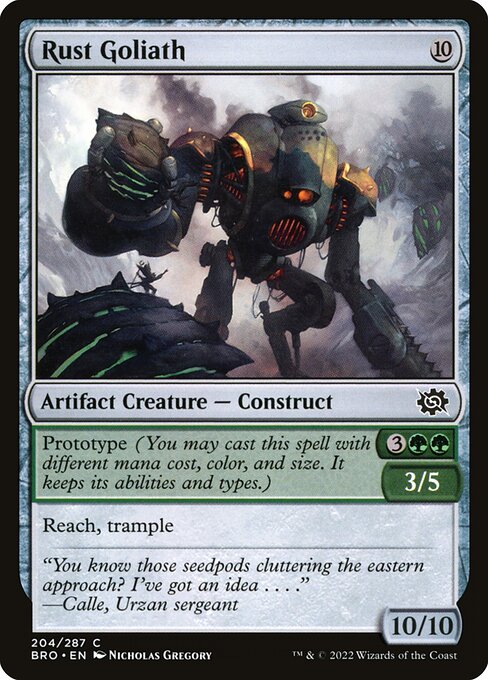
Inverse Kicker, Semi-Evoke, etc.
Prototype is a fascinating solution to multiple problems at once. How do you make a set about giant robots the size of Eldrazi function without recreating Rise of the Eldrazi? How do you make colors matter when colorless artifacts rule the day? What mana-smoothing mechanic will this set have, since basically every set needs one? And can all of this be done in a narratively cohesive way? Prototype aims to solve all at once.
Prototype is a modal mechanic (like Kicker and Split) that uses its text box to communicate different states (like Level Up, Mutate, and Adventure). You can pay the hefty cost in the top right corner to get the hefty stats in the bottom right corner (the way that all creatures work), or you can pay the cheaper, colored cost in the little box to get the littler stats in said box.
The frame is a lot to take in, but the mechanic seems straightforward beyond that: the Prototype and normal versions have the same abilities, card types, and creature types, it’s just their stats, color, and mana value that are different. This could lead to some memory issues in tabletop, but when the difference between the two modes is this massive, I’m optimistic that it won’t be a big deal.
Prototype is interesting next to Unearth, as they push in opposite directions. Prototype rewards you for having colors early, but comes at the cost of the card’s power. Unearth rewards you for having colors late and provides additional power. Prototype demonstrates a janky, early version of an artificer’s mighty weapon while Unearth demonstrates a janky, slapdash repair of an ancient war machine. And both pair incredibly well with Flicker effects.
Prototype also introduces a subtle new text innovation: the concept of “size.” Magic regularly adjusts its language, and size is a shorter and arguably more intuitive way to say “power and toughness.” I’m not sure whether “size” as a game term opens up any new design space, but just cleaning up text boxes is worthy cause in its own right—although sometimes freeing up space in text boxes seems to just allow for denser text boxes.
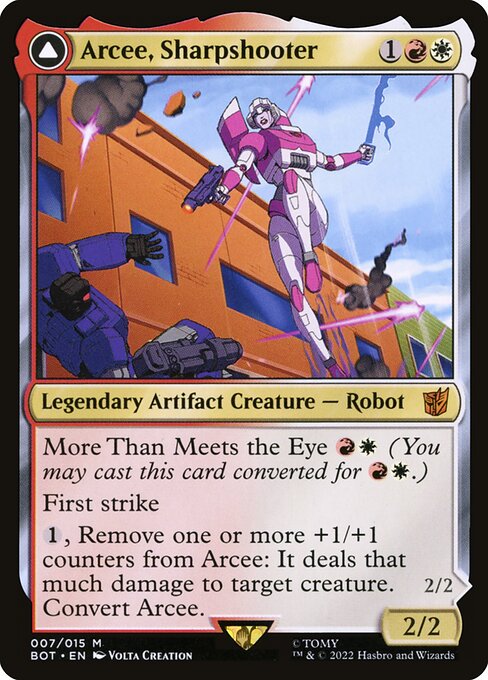
Transform by another name would still smell like grease
The first of the three mechanics introduced by the Transformers cards (which do not appear in Brother’s War draft boosters, but do appear in set and collector boosters) is Convert. It is identical to Transform, which was introduced in 2011’s Innistrad.
I don’t love Magic having two different mechanics that do exactly the same thing, but I think that Transformers toys technically convert rather than transform. This language will make the product more approachable to fans of Transformers who don’t yet play Magic (one of the primary motivations behind Universes Beyond products like this). Plus, this isn’t actually new to Magic—Grimlock, Dinobot Leader from 2017 converted rather than transformed.
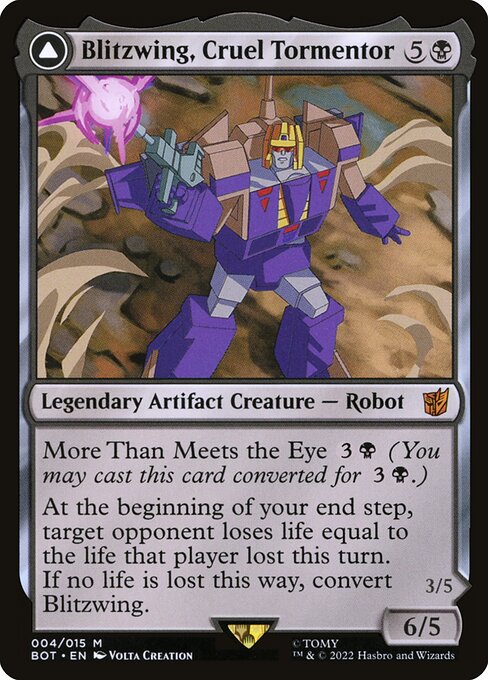
MTDFCs
More Than Meets the Eye is a new take on an existing mechanic: Modal Double-Faced Cards. It’s essentially the same thing (letting you play either side), but because the card also transforms/converts, the choice is very different. You’re not locking yourself into a specific card, you’re choosing which half of a complete game piece you’re starting with. This mechanic makes perfect sense for an IP about transforming robots and uses the brand’s most known catchphrase to sell itself. That makes for a strong mechanical package.
More Than Meets the Eye reminds a bit of the incredibly wordy Strixhaven deans, where cards were covered in text, demanded an immediate choice, and you literally couldn’t see all of the information at once. That’s a problem in a format like Limited where you’re seeing a lot of cards at once and need to take them all in. However, these cards won’t show up in Limited and seem heavily intended for Commander, the format where wordy legendary creatures work best. At the start of each game, everyone can read your Transformer and study it to understand exactly what it’s capable of.
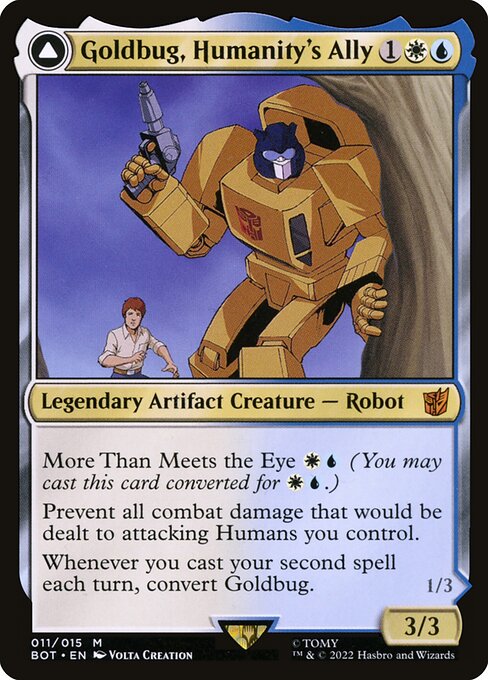
Self-driving cars
The most innovative mechanic in Transformers is Living Metal. Every transformer’s back face is a vehicle with no Crew ability, but effectively crews itself during your turn. Narratively, this makes perfect sense—Transformers do turn into vehicles and they do drive themselves. Mechanically, this is weird—they’re vehicles without the distinguishing feature of almost all vehicles, or they’re creatures with a bunch of weird quirks. But these concerns feel a bit paltry when we’ve just seen Weatherlight Compleated as a self-Crewing vehicle and Honeymoon Hearse as a vehicle without a Crew cost. And it does give the Transformers the feel of hiding in plain sight as a vehicle—that’s why they can’t block!
And with that, we’ve hit all five new mechanics. Next week, we’ll have a chance to play with all of them in prerelease, and I’ll be honest—I’m pretty excited to draft this set. Having played Magic in the 90s, I’m pumped to get to play with characters from my childhood and mechanically recreate their climactic events.
Zachary Barash (he/him) is a New York City-based game designer and the last commissioner of Team Draft League. He designs for Kingdom Death: Monster, has a Game Design MFA from the NYU Game Center, and does freelance game design. When the stars align, he streams Magic (but the stars align way less often than he’d like).

